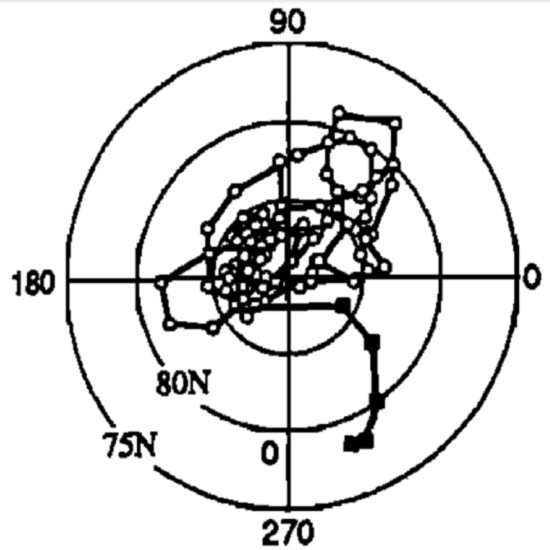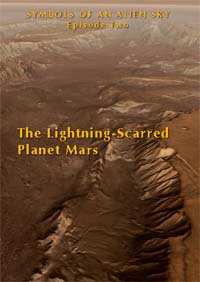|

Diagram showing the estimated path
of the north geomagnetic pole from
8000 BCE to 2000 CE.
Courtesy Masao Ohno and Yozo Hamano
Polar Wondering
Mar 16, 2011
Leibniz’ beloved adage that
natura non facit saltus or
‘nature does not make leaps’ has had
to endure a fair amount of
comeuppances since it gained
currency.
An arresting example today of our
unpredictable world is the rapid
wandering of the north geomagnetic
pole in recent years – an eastward
movement currently estimated at a
rate of 37 miles per year and
possibly still accelerating. The
surge of attention for this in the
popular media highlights a
widespread fear of the unknown, in
which the possibility of a complete
reversal of the earth’s magnetic
poles occupies a prominent part.
Yet although signs that the
earth’s magnetic field is really
about to reverse are wanting, the
likes of Carolus Linnaeus, Isaac
Newton, and Charles Darwin might
have turned over in their graves at
today’s grand display of nature’s
capriciousness.
Whereas newspapers and television
programmes delight in the phrase
that the north magnetic pole of the
earth has not been known to move
with such celerity “since records
began,” modern scientists are not at
all taken aback by these
developments, as such man-made
records are really all but hoary.
Archaeologists, climatologists
and geophysicists have been studying
records of past pole movements
buried in the earth’s crust since at
least a couple of decades.
Extracting archaeomagnetic
measurements from baked clay
materials, collected from
archaeological sites, and – for
earlier periods – from geological
sediments, painstaking analysis has
enabled researchers to model the
past evolution of the earth’s
magnetic field all the way back to
the onset of the Holocene.
As early as 1992, a Japanese team
published the diagram shown above,
mapping the path of the north
geomagnetic pole over the past 10
millennia. It transpires that
“distribution of the geomagnetic
pole was elongated to the direction
parallel to the meridian of 45º and
225º longitude, and westward
movement of the pole was predominant
throughout this period.”
Moreover, the polar trajectory
appeared to have involved three
different intervals: prior to 5,000
BCE, “the movement of the
geomagnetic pole was active, in
which it changed its position over
15 degrees”; the period between
5,000 and 1,700 BCE was
comparatively inactive, as “the
range of the movement of the
geomagnetic pole was limited within
5 degrees around the geographical
pole,” and from 1,700 BCE onward the
movement of the pole was again “very
active, fluctuating over 10
degrees,” so that “the geomagnetic
pole moved largely to the outside of
the circle of 80 degrees of north
latitude.”
The polar antics of antiquity
help to place recent displacement
patterns in a wider context. In
addition, knowledge of the past
positions of the poles is a vital
tool in the study of transient
celestial events in historical times
– for along with the geomagnetic
pole shifts the auroral oval,
beneath which displays of the aurora
are most frequent.
An especially active episode –
known among Russian researchers as
the Sterno-Etrussia geomagnetic
excursion – occurred between ±800
and ±600 BCE and lasted one or two
centuries. During this time, the
geomagnetic dipole inclined more
than 10º towards the East, taking it
to ±81.4º N, 45.1º E, just to the
northeast of Spitsbergen.
As the Babylonian city of Nippur
was located at the same longitude,
the dipole magnetic latitude of
Babylon at that time was 40.8º N, as
compared to the present-day value of
27.0º. This suggests “a higher
auroral incidence at Babylon in 567
BC than at present,” as some have
noted. It would also have
predisposed the area to a richer
variety of auroral forms, including
the occurrence of magnificent
overhead aurorae – or coronae; for
comparison, the overhead aurora of
14 May 1921 occurred at 40º magnetic
latitude, and the one of 1 September
1859 – the famous "Carrington Event"
– at 36º.
The hypothesis is confirmed in
fact by Babylonian observations of a
red glow at around ±600 BCE, as
mentioned in a cluster of cuneiform
texts. Similar records “were
uncommon in the centuries preceding
and following this date, consistent
with this being the only time over
the past few thousand years that the
magnetic pole was in the longitude
of Nippur (modern day Iraq).”
Indeed, as a handful of
researchers have argued, the very
outburst of auroral activity
exhibited in the skies over the
Middle East during this period was
almost certainly recorded in ancient
sources as a smattering of
"visions," including the famous
"vision of the chariot" reported by
the Hebrew prophet, Ezekiel. The
latter was essentially “a windstorm
coming out of the North,” “an
immense cloud with flashing
lightning and surrounded by
brilliant light.”
Despite the presence of
“lightning,” this was not an
ordinary tempest: the luminous
structure of wheels, animal-like
creatures, “an expanse, sparkling
like ice” and the crowning image of
the enthroned deity all find close
analogues in eyewitness reports of
the polar aurora.
In the bigger picture, it can be
shown that prophetic visions
reducible to auroral apparitions –
and perhaps accompanied by
hallucinations, induced by ambient
electromagnetic fields – have
fuelled significant changes in
prevailing cultural paradigms. It
may not be coincidental that the
Sterno-Etrussia geomagnetic
excursion roughly corresponds to the
so-called "axial age," which was
typified by spiritual revolutions
extending from Greece to China.
Confucianism and Daoism in China,
Buddhism and Jainism in India,
Zoroastrianism in Persia, the
reformative utterances of the Hebrew
prophets and Greek philosophy all
share a common origin in this epoch.
Although it is still premature to
finger a geomagnetic cause for this
age of reforms, the case of Ezekiel
justifies the search for a
correlation between geomagnetic
upheaval and the inspirational
visions had by many sages at this
time – suggesting that the polar
adventure of this era proved quite
beneficial to denizens of the Old
World. If the cultural history of
mankind thus progresses in leaps and
bounds, sometimes in tune with the
dance of the magnetic poles, all are
advised to allay "Doomsday" fears
and to enjoy the ride.
Rens Van Der Sluijs
http://mythopedia.info
Books by Rens Van Der Sluijs:
The Mythology of the World Axis
The World Axis as an Atmospheric
Phenomenon
Multimedia

The Lightning-Scarred Planet Mars
Symbols of an Alien Sky
DVD episode 2
A video documentary that could change everything you thought you knew
about ancient times and symbols.
The Symbols of an Alien Sky video series will introduce you to celestial
spectacles and earth-shaking events once remembered around the world.
Archaic symbols of these events still surround us, some as icons of the
world’s great religions, though the origins of the symbols appear to be
lost in
obscurity.
In this second episode of Symbols of an Alien Sky, David
Talbott takes the viewer on an odyssey across the surface of Mars.
Exploring feature after feature of the planet, he finds that only
electric arcs could produce the observed patterns. The high resolution
images reveal massive channels and gouges, great mounds, and crater
chains, none finding an explanation in traditional geology, but all
matching the scars from electric discharge experiments in the
laboratory.
(Approximately 85 minutes) See:
Lightning-Scarred
Planet info
|








